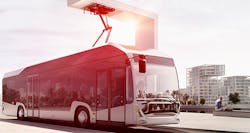Energy and power — most of us use these terms interchangeably, but in fact they’re two different things. Understanding the difference, and how they impact the cost of charging electric buses, can have a substantial impact on the business case for electrified transit.
“Power” is actually a rate-of-flow measure and for charging applications is typically stated in kilowatts. Energy, on the other hand, is a static quantity. It’s measured in kilowatt-hours, which indicate electric current flowing at a certain rate (kilowatts) for a certain time (hours). So, you could arrive at the same total energy with any number of combinations of power and time (e.g., low power for a long time or higher power for a shorter time).
This distinction is important because utility costs are not simply a matter of energy consumed. Commercial and industrial users also pay “demand charges” that are applied based on the highest power level required in a given billing period. Demand, in utility terms, is usually an average of power levels over a 15-minute interval. Your highest 15-minute average in the month sets the demand charge.
Demand charges can be steep, especially for transit operators because charging applications are “peaky”, drawing electricity from the grid at high-power levels, especially if multiple chargers are operating simultaneously. Lower-power depot charging can take up to 8 hours, but opportunity and en-route charging happen in minutes and that implies higher power levels and higher demand. In the case of a DC fast charger, we’re talking about power levels as high as 600kW, which is four times that of the highest powered “slow” charger.
Paradoxically, the advance of battery technology is exacerbating the demand charge challenge. The energy density of battery packs used in EV applications has more than doubled in just the last five years. That has greatly extended the range of the vehicles that rely on them, but the larger batteries also take longer to charge. Charging at higher power levels can shorten the time, but that of course means—you guessed it—higher peak demand.
So, what’s a transit operator to do? One option for addressing demand charges is energy storage. The ability to draw power from the grid when charging demand is low and release it when it is high reduces peak demand, though obviously there is a substantial cost in adding a storage device to your charging infrastructure. However, the cost of battery storage is dropping as energy densities increase, which will make storage more economical going forward
Opportunity charging can also help by breaking down the charging process into smaller (perhaps more frequent) bites spread out during the day. Optimizing vehicle use is also important to make the best use of en-route and opportunity charging.
Stephanie Medeiros is a sales manager, Electric Vehicle Charging Infrastructure, with ABB.
This article first appeared on the www.abb-conversations.com website on 4/9/18 at www.abb-conversations.com/2018/04/demand-charges-and-how-to-mitigate-them




